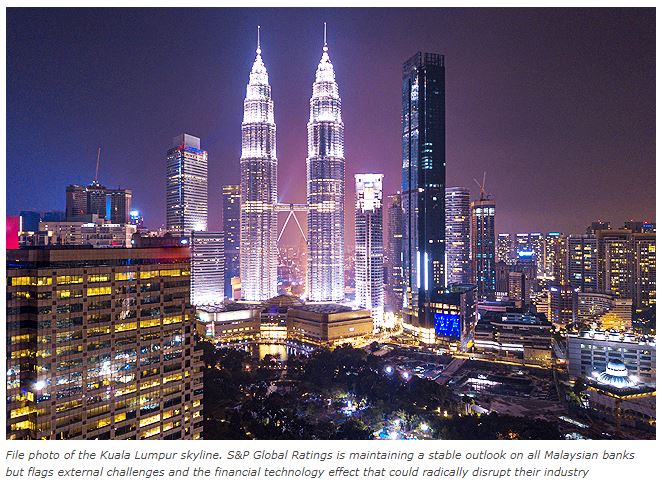S&P maintains stable outlook for Malaysian banks, flags fintech effect
KUALA LUMPUR (Bernama) — S&P Global Ratings is maintaining a stable outlook on all Malaysian banks but flags external challenges and the financial technology (fintech) effect that could radically disrupt their industry.
Malaysia’s banks are battling on multiple fronts namely a trade war, a China-led regional economic slowdown, dampened domestic business sentiment, and continuously soft commodities prices.
“Moreover, the lenders need to contend with the possibility that financial technology may radically disrupt their industry, just as they are shaving costs,” said S&P Global Ratings analyst Rujun Duan.
“While such factors don’t yet affect our ratings – we maintain a stable outlook on all the Malaysian banks we rate – we believe it’s critical to flag the issues,” she said in a report titled Malaysian Banking Outlook: Incumbents Feel The Squeeze.
Malaysia’s incumbent lenders are facing cyclical and secular pressures that may slowly erode their financial standing if not addressed.
She said S&P projects Malaysian bank loans to grow three to five per cent in 2019, about half the growth achieved in 2015.
“We also expect the industry’s net interest margin will contract five to 10 basis points in the year, following cuts to the policy rate and heated domestic competition for deposits,” she said.
Malaysian households have been deleveraging for the past three years. Most recently, the trade war and volatile capital markets have weighed on consumer sentiment and discouraged business investment.
Given that Malaysian banks do over half (58 per cent) of all lending to households, any indicator suggesting softness in household borrowing bodes poorly for lenders.
Bank Negara Malaysia trimmed the policy interest rate by 25 basis points in May, and one more interest rate reduction is expected this year. The United States (US) Federal Reserve’s more accommodative monetary policy has given room for regional central banks to ease policy, weighing on banks’ net interest margin.
Competition for cheap, sticky retail deposits flares up repeatedly as banks vie for high-quality, liquid assets. All of this pressures margins, worsening banks’ profit outlook.
Seeing few growth areas, Malaysian banks have responded by trimming operational costs, closing branches, and retrenching staff. The cost-to-income ratio in the sector has stayed at around 47 per cent – 48 per cent over the past two years.
“While banks have been striving to improve this ratio, we believe that is unlikely without better support from earnings,” Duan noted.
Malaysian banks have also diversified to countries such as Singapore and Indonesia. Generally, this is a good strategy as the net interest margin is higher in these markets.
“But when times are bad, Malaysian banks’ overseas operations tend to drag down group profit, as seen in recent years’ losses in the Singapore offshore oil and gas sector, and the Indonesian mining and commodities sectors,” she said.
Singapore, being a highly open economy, is likely to feel the full effect of macro-headwinds over the next 12-18 months, limiting the profit upside for banks.
Notably, the Singapore economy grew by just 0.1 per cent year-on-year in the second quarter, a marked slowdown from the 1.1 per cent growth logged in the previous quarter, said Duan.
In this climate of cost-cutting and strained profit arrives digital banking. Malaysian regulators are expected to hand out the country’s first digital banking licences in the next 12-24 months.
This will allow local tech and telecoms groups such as Grab Holdings Inc and Axiata Group Bhd to compete directly with banks in lending and deposits-taking, without the encumbrance of an expensive branch network.
International leading technology giants such as Alibaba Group and Tencent Holdings, which already have a meaningful share of Malaysia’s digital payments market, could challenge the Malaysian lenders. Both have proved highly competitive in digitalised financial services in China.
“Tech groups have the potential to compete with traditional lenders on almost all fronts in retail banking. To manage this threat, incumbent banks will need to invest heavily in technology,” she added.
Source: https://borneobulletin.com.bn/sp-maintains-stable-outlook-malaysian-banks-flags-fintech-effect/


 English
English




